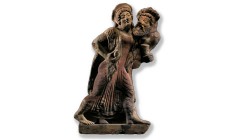The Internet market in Precolumbian antiquities
Brodie, N. (2014) ‘The Internet market in Precolumbian antiquities’, in Kila, J. and Balcells, M. (eds.) Cultural Property Crime: An Overview and Analysis on Contemporary Perspectives and Trends. Leiden: Brill, pp. 237–262.
The first secure online retail transaction took place in August 1994 (Ariguzo et al. 2006: 240). The following year saw the establishment of Internet sales as a viable commercial strategy with the launch of Internet retailer Amazon and Internet auction site eBay (Krishnamurthy 2004: 32–33). Amazon and eBay also pioneered two alternative models of online commercial interaction: business to consumer (B2C) in the case of Amazon, and consumer to consumer (C2C) in the case of eBay. By 2011 it was estimated that at least 2.3 billion people had access to the Internet, and even with over sixty percent of that fijigure in the developing world (unodc 2013: xvii), the residue of potential customers in the developed world is an attractive prospect for any commercial venture.
The rapidly expanding world of Internet commerce offered new opportunities for antiquities merchants and for criminal abuse of the antiquities market. Traditionally, antiquities collecting and trade had been high-class affairs, with rich museums and collectors served by a small number of well- established dealers and auction houses. Yet already in the 1990s, moves were afoot to commercialize the antiquities trade by offering poorer quality or less- expensive antiquities to a broader and economically more diversified customer base, by developing transactional spaces outside the traditional and—for inexperienced customers—intimidating contexts of merchant galleries and auction rooms, and by emphasizing the decorative and fijinancial rather than aesthetic and scholarly attributes of the antiquities for sale. Small trade fairs offered the enticing prospect of a pleasant day out, and mail-order schemes allowed purchases to be made in the reassuring comfort of the customer’s own home (Brodie 2004: 89–91). These tentative moves to grow the customer base by expanding downmarket were soon overwhelmed by the growing opportunities of Internet commerce, however, and it was not long before an online antiquities market became an established reality, with both B2C and C2C sales strategies allowing the participation of collectors from a much broader range of socioeconomic backgrounds than had previously been the case. The emerging Internet market also worked against traditional merchants who maintain galleries in expensive locations like New York or London and favored a new business model whereby large inventories can be stored in low-cost locations (McAndrew 2012: 104).
